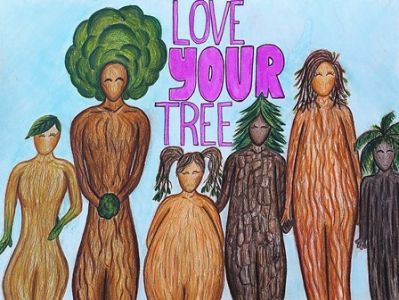
Love Your Tree uses art to grow body positivity among students
By: Jordan Cope, Senior Editor
Featured image courtesy of Tavi Steckel
Just as trees have different characteristics to make them unique from all the others, so too does the human body.
“Like a tree, my body is strong,” “like a tree, my body is growing,” and “like a tree, my body is unique” are just some of the ways that participants in the Love Your Tree campaign have been relating their bodies to trees as a form of body positivity.
Since 2006, The Center for Eating Disorders at Sheppard Pratt has been running this campaign designed to help middle, high school and college students develop positive body image and enhance media literacy skills about beauty.
“[The program] is designed to develop a healthy relationship with oneself and serve as armor to be comfortable with your body,” said Brianna Garrold, an art therapist at The Center.
The campaign was created by The Center’s leading art therapist Julia Andersen. Andersen found her inspiration for the program through author and playwright Eve Ensler’s play, “The Good Body.”
In her one-woman play, Ensler uses the metaphor of a tree to embrace unique characteristics of the human body and to create a different standard for beauty in society.
Schools and universities that participate in the campaign hold body positivity workshops and create posters using the tree metaphor to express how they view their bodies.
“We want [students] to make art that makes them unique,” Garrold said. “Art is a powerful tool. It makes it easier to express yourself, and it serves as a safety net for students who are not comfortable communicating their feelings in a verbal way.”
Towson University currently offers the Love Your Tree campaign to its students through Body Image Peer Educators at the Counseling Center, in addition to 10 other programs.
Active Minds, mental health advocacy student organization at Towson, works closely with the Body Image Peer Educators to promote positive body image.
Stephanie Lietzau, secretary of Active Minds, said that art therapy is something that is heavily focused on at the Counseling Center.
“We do a lot of self-care [and] stress management techniques,” Lietzau said. “One of the things that people always bring up is painting [and] drawing. Art therapy is definitely a really good thing to have, and there are resources at the Counseling Center for that.”
Since the Love Your Tree campaign began, over 2,700 posters have been submitted. Garrold said that she believes that number will increase as the program continues to grow.
“We want everyone to know that everyone comes from different walks of life, and that you are unique and that you are special and that you are important,” she said.

